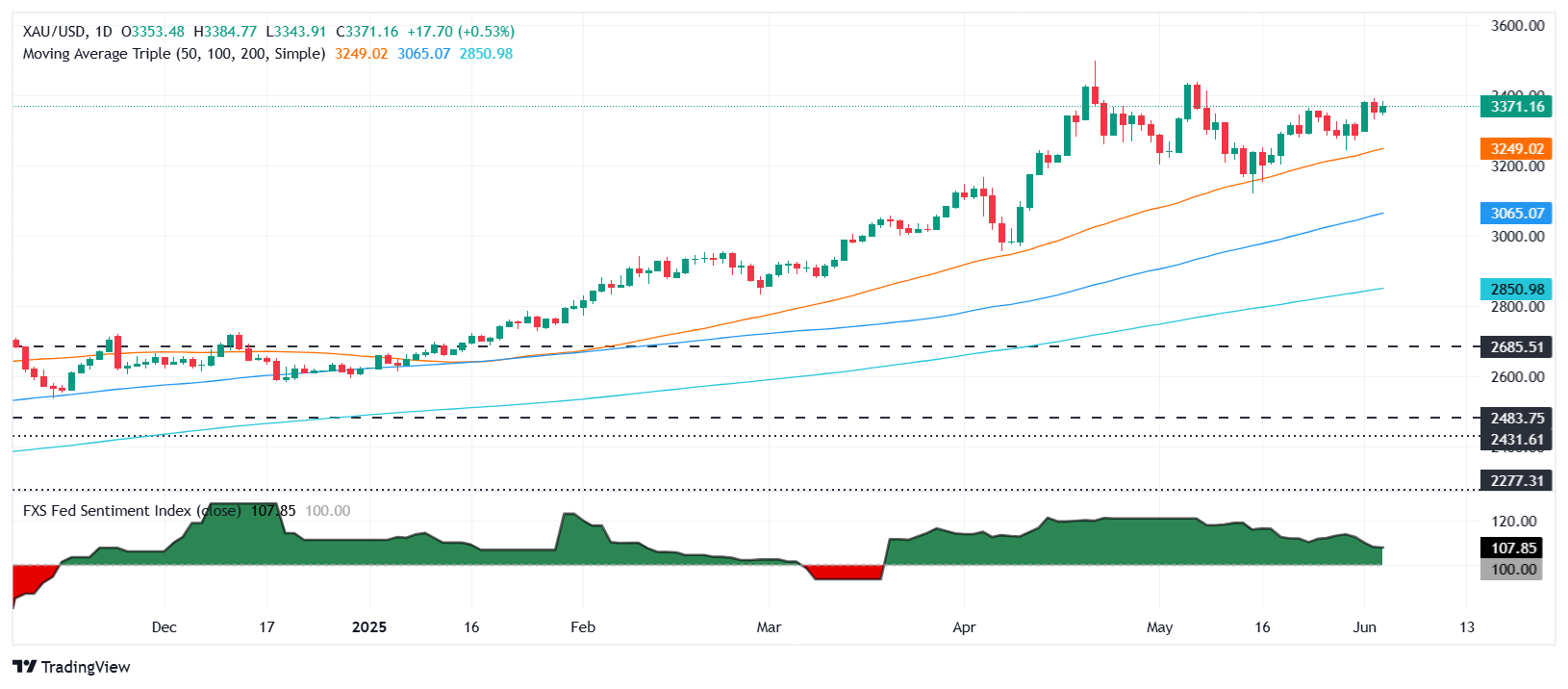- Gold rallies from $3,343 low after ISM and ADP reports confirm US economic slowdown.
- Trump signs executive order raising metal tariffs to 50%, escalating US-China trade tensions.
- Fed officials remain cautious on easing; markets await Jobless Claims and NFP for further policy cues.
Gold price rallied over 0.80% on Wednesday during the North American session. The release of weaker-than-expected economic data from the United States (US) pushed XAU/USD higher as business activity softened and the jobs market added fewer people to the workforce. The golden metal trades at $3,382 after hitting a daily low of $3,343.
Sino-US tensions had driven Bullion prices higher. Uncertainty about the outcome of the trade discussions between the White House and China and softer economic data in the US would underpin Gold prices.
In the meantime, US President Donald Trump signed an executive order increasing the levies on steel and aluminum from 25% to 50%, effective June 4, ahead of a scheduled phone call between Trump and China’s President Xi Jinping later this week.
US economic data revealed that the economy is cooling, which could warrant further action by the Federal Reserve (Fed). The Institute for Supply Management (ISM) showed that business activity in the services sector contracted for the first time in almost a year. At the same time, private hiring in the country slowed sharply in May, according to the ADP National Employment Change data.
Following the data release, Trump complained about Fed Chair Jerome Powell being too late to lower borrowing costs. During the week, Fed officials expressed that they’re patient regarding resuming the ongoing easing cycle that started in the second half of last year, adding that the impact of tariffs is unknown, which could fuel a persistent rise in prices.
Ahead this week, traders are eyeing US Initial Jobless Claims for the week ending May 31, followed by Nonfarm Payroll figures on Friday.
Gold daily market movers: XAU/USD soars as US Treasury yields plummet, weighing on the US Dollar
- Gold price rallies as the US Dollar dives. The US Dollar Index (DXY), which tracks the value of the Greenback against a basket of six currencies, fell 0.44% down to 98.81.
- US Treasury bond yields are falling. The US 10-year Treasury yield plunges 7.5 basis points to 4.383%. US real yields have followed suit and are also down by the same amount at 2.063%, a tailwind for Bullion prices.
- The ADP National Employment Change figures for May rose by 37K, missing estimates of 110K and below the previous month’s revised 60K print.
- The ISM Services PMI tumbled from 51.6 in April to 49.9 in May, below forecast of 52.0.
- Money markets suggest that traders are pricing in 54 basis points of easing toward the end of the year, according to Prime Market Terminal data.
Source: Prime Market Terminal
XAU/USD technical outlook: Gold remains bullish, but buyers are reluctant to crack $3,400
Technically, Gold price is upwardly biased, but during the session it has failed to clear the current week’s peak of $3,392. Momentum, as depicted by the Relative Strength Index (RSI), shows buyers are in charge.
If XAU/USD climbs past $3,400, this clears the path to test key resistance levels. First, the May 7 peak comes at $3,438, which is followed by the $3,450 figure and by the all-time high (ATH) at $3,500.
On the flip side, if Gold falls below $3,300, sellers could send XAU/USD on a tailspin toward testing the 50-day Simple Moving Average (SMA) at $3,235, followed by the April 3 high turned support at $3,167.

Gold FAQs
Gold has played a key role in human’s history as it has been widely used as a store of value and medium of exchange. Currently, apart from its shine and usage for jewelry, the precious metal is widely seen as a safe-haven asset, meaning that it is considered a good investment during turbulent times. Gold is also widely seen as a hedge against inflation and against depreciating currencies as it doesn’t rely on any specific issuer or government.
Central banks are the biggest Gold holders. In their aim to support their currencies in turbulent times, central banks tend to diversify their reserves and buy Gold to improve the perceived strength of the economy and the currency. High Gold reserves can be a source of trust for a country’s solvency. Central banks added 1,136 tonnes of Gold worth around $70 billion to their reserves in 2022, according to data from the World Gold Council. This is the highest yearly purchase since records began. Central banks from emerging economies such as China, India and Turkey are quickly increasing their Gold reserves.
Gold has an inverse correlation with the US Dollar and US Treasuries, which are both major reserve and safe-haven assets. When the Dollar depreciates, Gold tends to rise, enabling investors and central banks to diversify their assets in turbulent times. Gold is also inversely correlated with risk assets. A rally in the stock market tends to weaken Gold price, while sell-offs in riskier markets tend to favor the precious metal.
The price can move due to a wide range of factors. Geopolitical instability or fears of a deep recession can quickly make Gold price escalate due to its safe-haven status. As a yield-less asset, Gold tends to rise with lower interest rates, while higher cost of money usually weighs down on the yellow metal. Still, most moves depend on how the US Dollar (USD) behaves as the asset is priced in dollars (XAU/USD). A strong Dollar tends to keep the price of Gold controlled, whereas a weaker Dollar is likely to push Gold prices up.
Read the full article here


